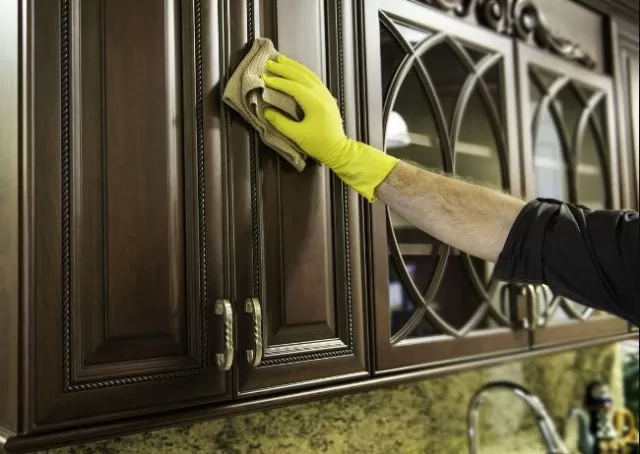Clean kitchen cabinets is often overlooked, but the accumulation of cooking grease can make them appear dull, dirty, and sticky
Before tackling the task of degreasing, it’s important to understand the cabinet material and which cleaning agents are safe and effective.
Ordinary household cleaners like distilled White Vinegar may not be strong enough for this heavy-duty job. Find the appropriate degreaser for your cabinet material and learn how to properly degrease kitchen cabinets.
How to remove grease from Kitchen cabinets when you Clean Kitchen

To remove sticky grease from kitchen cabinets, you can use a degreasing agent of your choice.
Follow these steps for effective degreasing when Clean Kitchen:
Step 1: Take a microfiber cloth and apply the degreaser to it.
Start from the top and work your way down, wiping the front of the cabinet doors to eliminate the sticky grease. If your cabinets have glass panels, clean both the front and inside of the glass.
Step 2: Once you have degreased the cabinet door fronts, open the doors.
Use the same cloth, adding more degreaser if necessary, and wipe the top, side, and bottom edges of the cabinet doors.
Step 3: Keep the cabinet doors open for easy access to the frame.
With the same cloth, apply the degreaser again if needed, and wipe the frame around the cabinet doors.
By following these steps, you can effectively degrease your kitchen cabinets and remove the Sticky Residue.
To select the suitable kitchen degreaser when Clean Kitchen

When it comes to choosing a suitable kitchen degreaser, it’s important to note that milder cleaning agents such as distilled white vinegar may not be strong enough for the task.
Opting for heavy-duty cleaners like ammonia-based degreasers or citrus oil degreasers is often more effective in removing sticky buildup. However, for those who prefer gentler options, a grease-cutting Dish Soap like Dawn can also be used.
To enhance the cleaning power of milder agents, using tools like a Dobie Pad or non-scratch scrub sponge can provide additional scouring capabilities.
To create an ammonia solution, mix 1 cup of ammonia with 1 cup of water, ensuring proper ventilation and wearing household gloves when handling it.
Alternatively, commercial degreasers containing ammonia can be purchased. It’s important to check the label of citrus oil degreasers to ensure comfort with the ingredients used.
Examples include Citrasolv, which is a gentle citrus degreaser, and ZEP Heavy-Duty Citrus Degreaser, which offers more intense cleaning power. When using dish soap, specifically those designed to cut grease like Dawn, a non-scratch abrasive sponge can be employed for added cleaning strength while remaining safe for the surfaces.
Pick the Right Cleaning Method for Each Cabinet Type

When it comes to clean kitchen cabinets, different types of cabinets require specific cleaning methods to ensure their preservation:
Wood Cabinets:
Consult the manufacturer’s instructions before cleaning to avoid damaging the seals.
Avoid oversaturating the cabinets with moisture. Apply the cleaning agent to a cloth instead of spraying it directly.
Wring out the cloth to ensure it is damp but not dripping before using it on painted cabinets. Laminate Cabinets:
Laminate cabinets are more forgiving and can be safely degreased with most cleaning agents.
Avoid using abrasive cleaners or scouring pads that could scratch the finish. Glass-Front Cabinets:
Consider the material surrounding the glass when selecting a cleaning agent.
Use a glass cleaner with ammonia and a microfiber cloth for the non-glass cabinet material. Avoid oil-based cleaners on non-glass areas to prevent streaks or dull spots on the glass.
Alternatively, dilute a grease-cutting dish soap like Dawn in water as a gentler cleaning agent. If using dish soap, follow up with a traditional glass cleaner to remove any streaks or water spots.
Clean both the outside and inside panels of glass cabinets. Remember to always follow the manufacturer’s guidelines and instructions for your specific cabinet type to ensure proper care and maintenance.
*The information is for reference only.